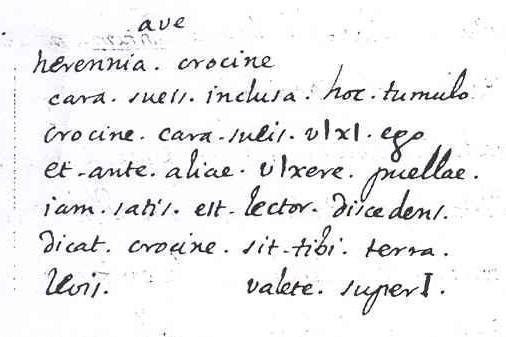Epitaph of Herennia Crocine
Reference CIL II 1821, CLE 1566 | Description | Lyrics | Location | Chronology | Epigraphic edition | Translation | Apparatus | Comentary | Type of verse | Text divided into verses and metric signs | Images | Bibliography | Link to DB | Author |
Epitaph of Herennia Crocine
Description
- Idno filename 22/01/0066
- Type of inscription: Sepulcralis
- Material Description: According to the manuscript: bluish plaque of one finger’s thickness and the size of a half folio
- Conservation status: There is a hole in the lower edge, a sign of later re-use.
- Perdida
Location
- Place of discovery: Found on the road about a quarter league from the Puerta de la Tierra, Cádiz, on the day of the earthquake of 1 November 1755 (BCC 56-4-9).
- Geolocation
- Location with Modern Nomenclature España / Cádiz
- Location with Old Nomenclature Hispania / Baetica / Gaditanus / Gades
Chronology
- Inscription's dating: Between year 70 and year 130
- Dating explanation: The formula s. t. t. l. does not appear until halfway through the 1st c. AD, while c(arus/a) s(ui)s, appears later, towards the end of the 1st c. and the beginning of the 2nd c. AD.
Type of verse
- Type of verse: Commaticum
- Verse/line correspondence: No
- Prose/verse distinction: Si
Epigraphic edition
Ave
Herennia ▴ Crocine
cara ▴ sueis (!) ▴ inclusa ▴ hoc ▴ tumulo
Crocine ▴ cara ▴ sueis (!) ▴ víxí ▴ ego
5 et ▴ ante ▴ aliae ▴ víxere ▴ puellae
iam ▴ satis ▴ est ▴ lector ▴ discedens
dicat ▴ Crocine ▴ sit ▴ tibi ▴ terra ▴
levis ▴ (vac.) valete ▴ superí
Text divided into verses and metric signs
Inclusa hoc tumulo Crocine, cara sueis. ll|lkk|l||kkl|lkk|~
Vixi ego et ante aliae vixere puellae. lkk|lkk|l/l|lkk|l~
Iam satis est. Lector, discedens, dicat: ‘Crocine, sit tibi terra levis’. lkk|l/l|l/l|ll||llkk|l||lkk|lkk|~
Translation
“Hail, Herennia Crocine, loved by her own. In this tomb is buried Crocine, loved by her own. I have lived and other young girls before me have lived. It is enough. May the reader say as he departs: “Crocine, may the earth rest lightly on you”. May you above fare well”.
Bibliography
Velázquez, ms. s. XVIII, 35c a Carbonel (inde Hübner, II 1821 [inde Bücheler, CLE 1566, cuius exemplum in linguam Hispanicam vertit Fernández Martínez 1998-99; Cholodniak 1904, 1062; Dessau, ILS 8130; Romero de Torres 1934, 145; Warmington 1940, n. 90; Mariner 1952, 4–6 et 178; Batlle 1963, n. 79; Lewis – Meyer 1963, 490 n. V; Krummrey 1961, 64– 65 [= id. 1967, 144]; Vives, ILER 3812a; Storoni 1973, n. 50; González, IRCa, 217; Thigpen 1995, n. 9, quae in linguam Anglicam vertit]); Anonymvs, ms. BCC 56-4-9, 106r.; ex Velázquez et Anonymvs Gómez Pallarès – del Hoyo – Martín Camacho 2005, 219–230; Martín Camacho, CLEB ES, CA1, qui in linguam Hispanicam vertit. – Cf. Ferreira 1996, 117–118; Hernández Pérez 2001a, 83. 90-91. 168. 171–172. 229–230. 235. 241. 244. 249. 253; Rodríguez-Pantoja 2010, 20.
Comentary
Carmen commaticum in dactylics, although there is no metrical unit: ll. 1-3 (sueis), praescriptum; ll. 3-4 (de inclusa a sueis), pentameter, with a single error caused by the insertion of the cognomen, from vixi to puellae, five last feet of a hexameter; l. 6 to levis in l. 8, dactylic sequence based on a formulaic pentameter to which the name of the deceased and the appeal to the reader has been added (cf., for example, CLE 1482,2: et tu praeteriens dicas: Procule, s(it) t(ibi) t(erra) l(evis); or also CLE 1193,3; CLE 1537,8; etc.); valete, superi, non-metrical sequence.
A primitive form of the dialogue between a passer-by reading the stone and the deceased to whom it belongs (cf. Gómez Pallarès-Del Hoyo Calleja-Martín Camacho 2005, 222-223). Ll. 4-5. topos of consolatio per exemplum, cf. Sen. epist. 77,12,7 and, e.g., CLE 1167,5-6 or CLE 971,14-15. For the farewell in l. 6, cf. CLE 1523,11 or CLE 52,8. For the petition to the passer-by to say her name and wish that the earth may rest lightly on her, cf., SE12,5-6; J5,3; or T9,15. L. 8. superi refers to the living in general, cf. ad CLE 179,1 or CLE 1567,11.
The use of “ei” in sueis to indicate the long “i” and the appearance in the same inscription of the feature that replaced it (the i longa) could suggest a period of transition between both forms, between the end of the Republic and the beginning of the Empire (cf. Mariner 1952, 5).
Author
- Author:J. Martín Camacho
- Last Update2023-11-21 12:02:27
You can download this




